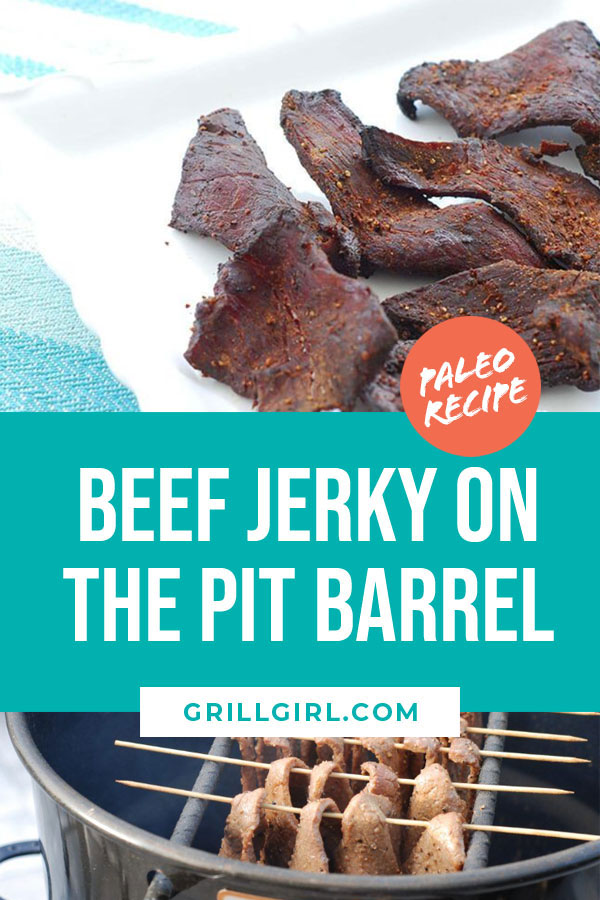The key to cooking your jerky in the Pit Barrel is to start with a small, controlled fire and to keep an eye on your jerky to make sure it is not cooking too quickly. Expect a cook time of between 2-3 hours, adding charcoal as needed to maintain the fire but never letting it get too big or hot. This beef jerky recipe uses Tamari, which is a Japanese Soy Sauce that is gluten-free and Paleo-friendly. You can also use Soy Sauce but slightly reduce the amount so it is not too salty.

The jerky starts by hanging from skewers and is then finished on the grates. The jerky should be on the indirect side of the grill, as far from the coals as possible.

After the jerky has reduced down on the skewers, finish the pieces that still have wet spots on the grill grates.
About the Pit Barrel Cooker
The Pit Barrel Cooker is a drum grill and smoker that produces awesome results with minimal effort. The PBC acts like a rotisserie by hanging meat, where it cooks convection style over the coals, producing juicy, moist, results. You can also grill on the PBC – it functions as both a smoker and grill and is extremely versatile. Stay tuned for more recipes developed specifically for the Pit Barrel.
Note: This is a sponsored post, however, I only endorse products I recommend!


Beef Jerky on the Pit Barrel Cooker
Ingredients
• 2 lbs beef- Use Top Round, Eye Round or Flank Steak- (jerky meat should be lean with minimal fat)
• 1/3 cup Tamari
• 1/2 tbsp sea salt
• 1 tbsp course ground pepper
• 4 garlic cloves
• 1 tsp onion powder
• 1 tsp smoked paprika
• 1/2 tsp apple cider vinegar
• 1 tsp agave syrup
Additional Materials
• 12 skewers
• Charcoal
• Wood for smoking- I recommend pecan, hickory or cherry
Instructions
Overview
Marinate the meat overnight, or for a minimum of 8 hours for maximum flavor. On the grill, the meat is going to hang on skewers to be as far away from the flame as possible and then transition to the grates at the end to ensure all pieces are fully dehydrated over the course of the cook.
Directions
- Combine all the ingredients for the marinade, then pulse with a stick blender/immersion blender to fully mix all ingredients together and chop the fresh garlic.
- Slice the meat into 1/4” slices, removing all fat. Cut it in half so each strip is no longer than 5 inches in length and no longer than 4 inches in width.
- In large gallon zip lock bags, add the meat and the marinade and let marinate in the fridge overnight.
After removing from the fridge
- Double up the skewers so that each piece is hanging from two skewers. The double skewers ensure the weight of the meat doesn’t cause the skewer to break. Make sure the meat pieces are not touching each other. Leave enough room on each end (approximately 4 inches) of the skewer so that there is room to hang on the rods of the PBC.
- Fill less than half of a standard chimney starter with Kingsford Charcoal and ignite it. Don’t let it get fully lit- only 3/4 of the way. Dump the charcoal into the Charcoal Ring and move it to one side.
- On the opposite side of the charcoal, hang your skewers on the rods suspending your jerky above the unlit/indirect side of the charcoal.
- Add your preferred wood to the fire.
- Let the jerky smoke for 2 hours (lid closed), watching it very closely the ENTIRE time. The skewers closest to the flame will need to be rotated to the other end of the barrel so they do not overcook. Add charcoal briquettes as needed to maintain the fire but never letting it get too big or hot.
- **If using lump charcoal, use the same amount of charcoal in the starter. However, you can use a spray bottle and mist the lump if it is getting too hot. This cannot be done with Kingsford as it gets sandy/mushy.
- After the jerky has dehydrated and cooked down- approximately two hours or so, some pieces may still have “wet spots” or areas that may have touched others or haven’t fully dehydrated. At this point, remove the jerky and rods and add the grate. Remove the jerky pieces and lay on the grate on the indirect side. Some pieces may already be done and will not need this final step.
- Let these remaining pieces continue to dehydrate on indirect until there are no “wet” parts left on the jerky, this will be a manual process- keep an eye on your PBC! This could take 30 minutes to an hour.
- Once all “wet” spots are dehydrated and the jerky has reduced in size and is firm yet still flexible, it is ready to eat.
Store in the refrigerator for maximum freshness- the jerky will last a few weeks. Enjoy!
Check out these related posts!





